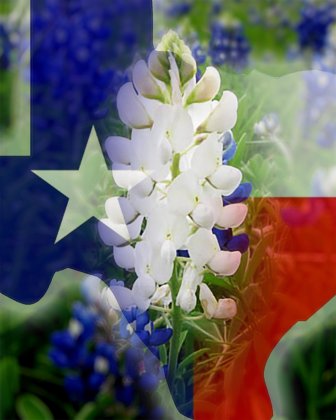A white bluebonnet in a field of blue
'They’ve painted the rolling hills of Lavaca County'
By: Jimmy Appelt & Bobby Horecka
Art by: Michelle Price
Most anyone who has driven much any distance at all lately has likely gotten an eyeful of the many fields to be found that are just as blue as the sky thanks to our magnificent state flower, the Bluebonnet.
Yes, they’ve painted the rolling hills of Lavaca County—in fact, much of the Lone Star State this year—in ways that few have before witnessed, and thanks to a few late-arriving cold spells and some nice, gentle rains, the lavish blooms didn’t just appear and vanish in mere days like they’re often prone to do here in Texas.
Rather, they’ve stuck around a while. For a full month already in some places, with no signs of slowing down any on their immediate horizon.
It’s made for one dazzling array everywhere you look, as more and more wildflowers continue to crop up in astounding abundance this spring.
Because it’s not just our state flower, acting alone. No, the stately bluebonnet gets joined this year by mile after mile of Indian paintbrushes (or, red blankets, as they are also sometimes called), primroses (buttercups), phlox, and a host of other blossoming natives, all working to show off our gorgeous landscapes in a way that only Mother Nature can.
Perhaps it’s because they’ve simply been around for as long as they have this year, but even in our most regal blankets of azure this year, we’ve gotten several reports now from folks around the county in ever greater regularity about this year’s crop of bluebonnets that, well—ain’t quite as blue as most folks remember.
In fact, if you look long and hard enough, it’s not too uncommon to find actual and for-real bluebonnets popping up in all sorts of colors—pinks, pastels, even Aggie maroon in a few select spots—and, if you look hard enough, you might even spot one of the rarest beauties of all, one that’s solid ghost white.
Although all are genetically bluebonnets, the white and pink colored flowers are merely deviations colors we most regularly associate with the Texas bluebonnets. According to the Lady Bird Johnson Wildflower Center, the white color is caused by a genetic mutation that changes the blue pigment of the recognizable flower to take on a white, light blue, or even pink color.
Although they may indeed be rare, they’re hardly impossible to find, as many are discovering now.
Enjoy them while they last, however, because if the true master gardeners and botanists at Lady Bird Center have come to know one fact to be true, it is this: While the white bluebonnets are indeed a treat to see, rarely do they ever come back for a second showing with the spring bloom the following year.
Usually, wherever bluebonnets grow one year, they almost inevitably return in a year or so, especially when the flowers are left to seed out and begin their germination process in the typically rainy fall season.
The reason behind it not annually appearing is due to its genetic mutation and how close the root of the white bluebonnet grows near to the native bluebonnet.
If the flower grows close to the root of the bluebonnet, the flower will likely take on its blue appearance when it grows next year.
Also, if you are fortunate enough to find a white bluebonnet you can do the flower a big favor by taking photos and not picking them because picking them disrupts the normal seeding process.
According to legend, the colors of the white and pink bluebonnets bare a particular reason. As folklore has it, when a group of children was playing in a field filled with bluebonnets, they spotted both a white and pink bluebonnet.
Being inquisitive as to why the white and pink flowers were mixed in the sea of blue, the children asked their grandmother for an explanation. She told them that the white flower among the blue flowers meant it was the Lone Star on the Texas flag.
In explaining the meaning of the pink flower, the grandmother told them that the pink bluebonnet stood for honoring the soldiers who lost their lives at the Alamo. Whether or not you spot a white or pink bluebonnet, the normal bluebonnets are still putting on their show, too, though some fields are starting to fade in color as the days grow increasingly warmer.
While the bluebonnets may be losing some of their luster—past their peak, so to speak—Mother Nature continues to replace them with all manner of pinks, reds, oranges, and yellows, colors of every hue, as other wildflowers keep appearing to decorate right behind them.
As we move into the Easter week, stay safe as you travel along the roads in the county or across the state, and take in the magnificence of God’s creation, his fantastic masterpiece. It’s definitely a sight to behold.


